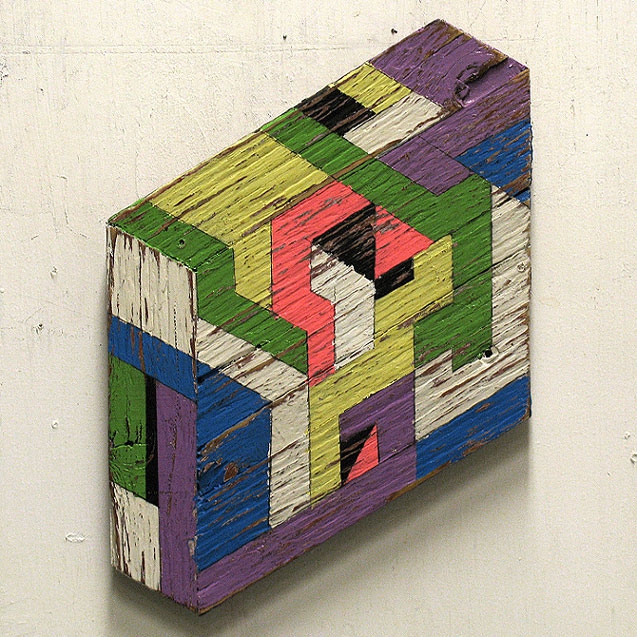The past and future collide in the geometric sculptures of Aaron Moran. The young Canadian artist grew up east of Vancouver, BC, studied at Emily Carr University of Art + Design and Film & Video at Simon Fraser University—recently serving as artist in residence at the Ranger Station Art Gallery in Harrison Hot Springs, BC. His work balances an interest in the fine line between the natural and man-made. He works mainly with reclaimed materials—often found wood from demolition sites—in two- and three-dimensional pieces that look like some kind of future primitive pyramids. Needless to say, we're big fans so we caught up with the artist by email to find out more.
Where do you usually find the wood you work with?
It is almost entirely found from demolished houses. I scour the lots that are being demolished to make way for condos/strip malls before they take it all off to the dump. Aside from that, I just keep my eyes peeled while I'm walking or driving around - I will gladly pick stuff up and carry it back to the studio if I'm out and about.
Do you paint the pieces or are all the colors from the salvaged wood?
It's probably 50/50 - when I do paint the pieces, it is usually to contrast fragments that were found already painted.
The shapes and geometric forms you create are very modern—which artists and influences led you to work with those kinds of shapes?
Kurt Schwitters, Michael Johansen, Juan Gris, Anish Kapoor, Boris Tellegen
What are you working on now?
I *just* finished a collection of pieces for a project with Sperry Topsider that was exhibited in Boston called "The Sea Project." This aside, I am working on a new group of what I would call 'two and a half dimensional' works that will be exhibited in February here in the Fraser Valley.
The past and future collide in the geometric sculptures of Aaron Moran. The young Canadian artist grew up east of Vancouver, BC, studied at Emily Carr University of Art + Design and Film & Video at Simon Fraser University—recently serving as artist in residence at the Ranger Station Art Gallery in Harrison Hot Springs, BC. His work balances an interest in the fine line between the natural and man-made. He works mainly with reclaimed materials—often found wood from demolition sites—in two- and three-dimensional pieces that look like some kind of future primitive pyramids. Needless to say, we're big fans so we caught up with the artist by email to find out more.
Where do you usually find the wood you work with?
It is almost entirely found from demolished houses. I scour the lots that are being demolished to make way for condos/strip malls before they take it all off to the dump. Aside from that, I just keep my eyes peeled while I'm walking or driving around - I will gladly pick stuff up and carry it back to the studio if I'm out and about.
Do you paint the pieces or are all the colors from the salvaged wood?
It's probably 50/50 - when I do paint the pieces, it is usually to contrast fragments that were found already painted.
The shapes and geometric forms you create are very modern—which artists and influences led you to work with those kinds of shapes?
Kurt Schwitters, Michael Johansen, Juan Gris, Anish Kapoor, Boris Tellegen
What are you working on now?
I *just* finished a collection of pieces for a project with Sperry Topsider that was exhibited in Boston called "The Sea Project." This aside, I am working on a new group of what I would call 'two and a half dimensional' works that will be exhibited in February here in the Fraser Valley.
